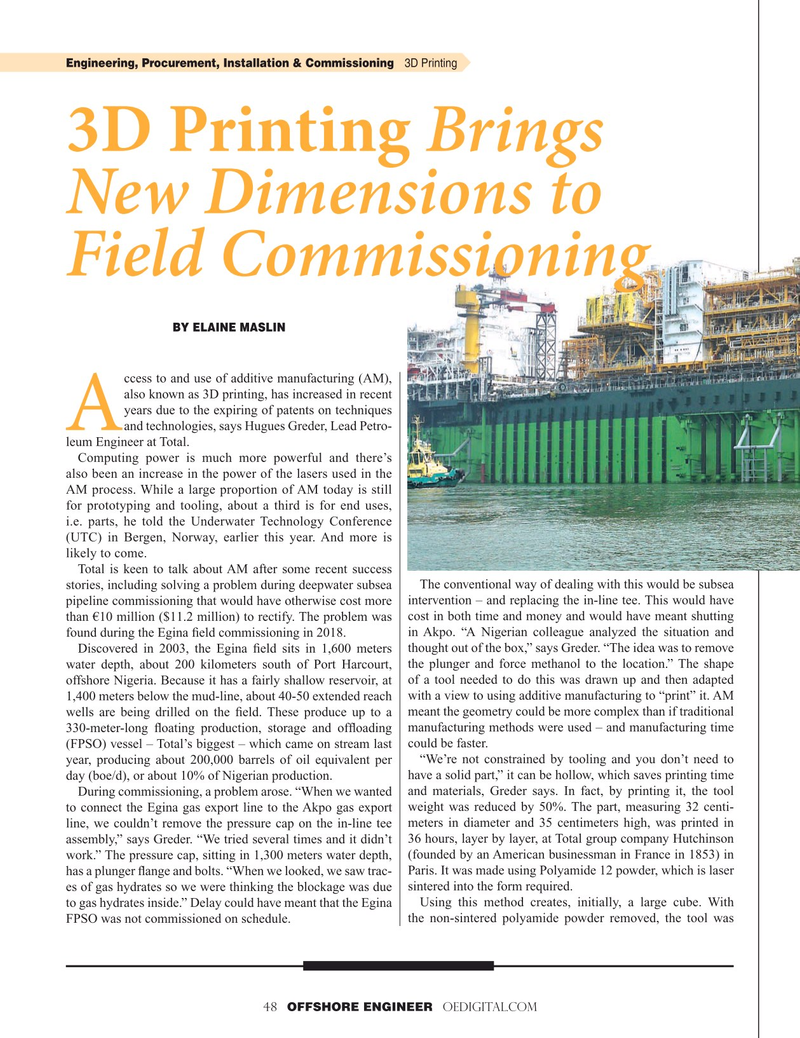
Page 48: of Offshore Engineer Magazine (Jul/Aug 2019)
Subsea Processing
Read this page in Pdf, Flash or Html5 edition of Jul/Aug 2019 Offshore Engineer Magazine
Engineering, Procurement, Installation & Commissioning 3D Printing 3D Printing Brings
New Dimensions to
Field Commissioning
BY ELAINE MASLIN ccess to and use of additive manufacturing (AM), also known as 3D printing, has increased in recent years due to the expiring of patents on techniques
A and technologies, says Hugues Greder, Lead Petro- leum Engineer at Total.
Computing power is much more powerful and there’s also been an increase in the power of the lasers used in the
AM process. While a large proportion of AM today is still for prototyping and tooling, about a third is for end uses, i.e. parts, he told the Underwater Technology Conference (UTC) in Bergen, Norway, earlier this year. And more is likely to come.
Total is keen to talk about AM after some recent success stories, including solving a problem during deepwater subsea The conventional way of dealing with this would be subsea pipeline commissioning that would have otherwise cost more intervention – and replacing the in-line tee. This would have than €10 million ($11.2 million) to rectify. The problem was cost in both time and money and would have meant shutting found during the Egina ? eld commissioning in 2018. in Akpo. “A Nigerian colleague analyzed the situation and
Discovered in 2003, the Egina ? eld sits in 1,600 meters thought out of the box,” says Greder. “The idea was to remove water depth, about 200 kilometers south of Port Harcourt, the plunger and force methanol to the location.” The shape offshore Nigeria. Because it has a fairly shallow reservoir, at of a tool needed to do this was drawn up and then adapted 1,400 meters below the mud-line, about 40-50 extended reach with a view to using additive manufacturing to “print” it. AM wells are being drilled on the ? eld. These produce up to a meant the geometry could be more complex than if traditional 330-meter-long ? oating production, storage and of? oading manufacturing methods were used – and manufacturing time (FPSO) vessel – Total’s biggest – which came on stream last could be faster.
year, producing about 200,000 barrels of oil equivalent per “We’re not constrained by tooling and you don’t need to day (boe/d), or about 10% of Nigerian production. have a solid part,” it can be hollow, which saves printing time
During commissioning, a problem arose. “When we wanted and materials, Greder says. In fact, by printing it, the tool to connect the Egina gas export line to the Akpo gas export weight was reduced by 50%. The part, measuring 32 centi- line, we couldn’t remove the pressure cap on the in-line tee meters in diameter and 35 centimeters high, was printed in assembly,” says Greder. “We tried several times and it didn’t 36 hours, layer by layer, at Total group company Hutchinson work.” The pressure cap, sitting in 1,300 meters water depth, (founded by an American businessman in France in 1853) in has a plunger ? ange and bolts. “When we looked, we saw trac- Paris. It was made using Polyamide 12 powder, which is laser es of gas hydrates so we were thinking the blockage was due sintered into the form required.
to gas hydrates inside.” Delay could have meant that the Egina Using this method creates, initially, a large cube. With
FPSO was not commissioned on schedule. the non-sintered polyamide powder removed, the tool was 48 OFFSHORE ENGINEER OEDIGITAL.COM

 47
47

 49
49